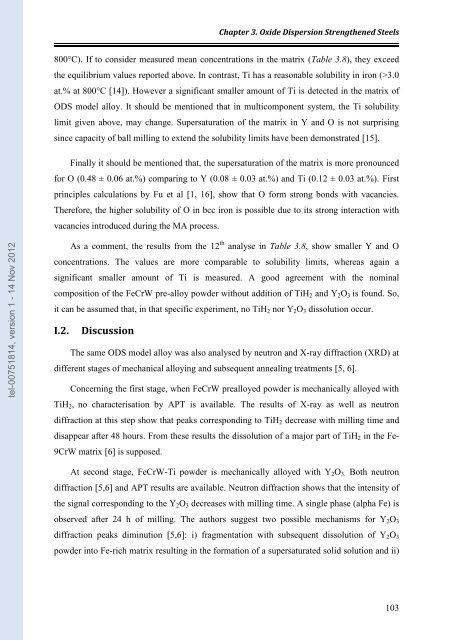Etude par Sonde Atomique Tomographique de la formation de nano ...
Etude par Sonde Atomique Tomographique de la formation de nano ...
Etude par Sonde Atomique Tomographique de la formation de nano ...
You also want an ePaper? Increase the reach of your titles
YUMPU automatically turns print PDFs into web optimized ePapers that Google loves.
tel-00751814, version 1 - 14 Nov 2012<br />
Chapter 3. Oxi<strong>de</strong> Dispersion Strengthened Steels<br />
800°C). If to consi<strong>de</strong>r measured mean concentrations in the matrix (Table 3.8), they exceed<br />
the equilibrium values reported above. In contrast, Ti has a reasonable solubility in iron (>3.0<br />
at.% at 800°C [14]). However a significant smaller amount of Ti is <strong>de</strong>tected in the matrix of<br />
ODS mo<strong>de</strong>l alloy. It should be mentioned that in multicomponent system, the Ti solubility<br />
limit given above, may change. Supersaturation of the matrix in Y and O is not surprising<br />
since capacity of ball milling to extend the solubility limits have been <strong>de</strong>monstrated [15].<br />
Finally it should be mentioned that, the supersaturation of the matrix is more pronounced<br />
for O (0.48 ± 0.06 at.%) com<strong>par</strong>ing to Y (0.08 ± 0.03 at.%) and Ti (0.12 ± 0.03 at.%). First<br />
principles calcu<strong>la</strong>tions by Fu et al [1, 16], show that O form strong bonds with vacancies.<br />
Therefore, the higher solubility of O in bcc iron is possible due to its strong interaction with<br />
vacancies introduced during the MA process.<br />
As a comment, the results from the 12 th analyse in Table 3.8, show smaller Y and O<br />
concentrations. The values are more com<strong>par</strong>able to solubility limits, whereas again a<br />
significant smaller amount of Ti is measured. A good agreement with the nominal<br />
composition of the FeCrW pre-alloy pow<strong>de</strong>r without addition of TiH2 and Y2O3 is found. So,<br />
it can be assumed that, in that specific experiment, no TiH2 nor Y2O3 dissolution occur.<br />
I.2. Discussion<br />
The same ODS mo<strong>de</strong>l alloy was also analysed by neutron and X-ray diffraction (XRD) at<br />
different stages of mechanical alloying and subsequent annealing treatments [5, 6].<br />
Concerning the first stage, when FeCrW prealloyed pow<strong>de</strong>r is mechanically alloyed with<br />
TiH2, no characterisation by APT is avai<strong>la</strong>ble. The results of X-ray as well as neutron<br />
diffraction at this step show that peaks corresponding to TiH2 <strong>de</strong>crease with milling time and<br />
disappear after 48 hours. From these results the dissolution of a major <strong>par</strong>t of TiH2 in the Fe-<br />
9CrW matrix [6] is supposed.<br />
At second stage, FeCrW-Ti pow<strong>de</strong>r is mechanically alloyed with Y2O3. Both neutron<br />
diffraction [5,6] and APT results are avai<strong>la</strong>ble. Neutron diffraction shows that the intensity of<br />
the signal corresponding to the Y2O3 <strong>de</strong>creases with milling time. A single phase (alpha Fe) is<br />
observed after 24 h of milling. The authors suggest two possible mechanisms for Y2O3<br />
diffraction peaks diminution [5,6]: i) fragmentation with subsequent dissolution of Y2O3<br />
pow<strong>de</strong>r into Fe-rich matrix resulting in the <strong>formation</strong> of a supersaturated solid solution and ii)<br />
103

















